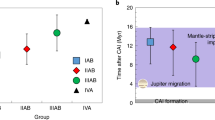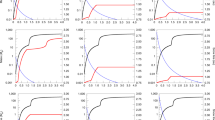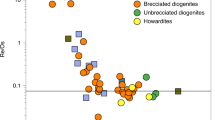Abstract
In our Solar System, the planets formed by collisional growth from smaller bodies. Planetesimals collided to form Moon-to-Mars-sized protoplanets in the inner Solar System in 0.1–1 Myr, and these collided more energetically to form planets1. Insights into the timing and nature of collisions during planetary accretion can be gained from meteorite studies. In particular, iron meteorites offer the best constraints on early stages of planetary accretion because most are remnants of the oldest bodies, which accreted and melted in <1.5 Myr, forming silicate mantles and iron-nickel metallic cores2,3,4. Cooling rates for various groups of iron meteorites suggest that if the irons cooled isothermally in the cores of differentiated bodies, as conventionally assumed, these bodies were 5–200 km in diameter5,6. This picture is incompatible, however, with the diverse cooling rates observed within certain groups, most notably the IVA group7,8, but the large uncertainties associated with the measurements do not preclude it. Here we report cooling rates for group IVA iron meteorites that range from 100 to 6,000 K Myr-1, increasing with decreasing bulk Ni. Improvements in the cooling rate model, smaller error bars, and new data from an independent cooling rate indicator9 show that the conventional interpretation is no longer viable. Our results require that the IVA meteorites cooled in a 300-km-diameter metallic body that lacked an insulating mantle. This body probably formed ∼4,500 Myr ago in a ‘hit-and-run’ collision between Moon-to-Mars-sized protoplanets10. This demonstrates that protoplanets of ∼103 km size accreted within the first 1.5 Myr, as proposed by theory, and that fragments of these bodies survived as asteroids.
This is a preview of subscription content, access via your institution
Access options
Subscribe to this journal
Receive 51 print issues and online access
$199.00 per year
only $3.90 per issue
Buy this article
- Purchase on Springer Link
- Instant access to full article PDF
Prices may be subject to local taxes which are calculated during checkout




Similar content being viewed by others
References
Chambers, J. E. Planetary accretion in the inner Solar System. Earth Planet. Sci. Lett. 223, 241–252 (2004)
Kleine, T., Mezger, K., Palme, H., Scherer, E. & Münker, C. Early core formation in asteroids and late accretion of chondrite parent bodies: Evidence from 182Hf-182W in CAIs, metal-rich chondrites, and iron meteorites. Geochim. Cosmochim. Acta 69, 5805–5818 (2005)
Scherstén, A., Elliott, T., Hawkesworth, C., Russell, S. & Masarik, J. Hf-W evidence for rapid differentiation of iron meteorite parent bodies. Earth Planet. Sci. Lett. 241, 530–542 (2006)
Hevey, P. J. & Sanders, I. S. A model for planetesimal meltdown by 26Al, and its implications for meteorite parent bodies. Meteorit. Planet. Sci. 41, 95–106 (2006)
Wasson, J. T., Matsunami, Y. & Rubin, A. E. Silica and pyroxene in IVA irons; possible formation of the IVA magma by impact melting and reduction of L–LL-chondrite materials followed by crystallization and cooling. Geochim. Cosmochim. Acta 70, 3149–3172 (2006)
Chabot, N. L. & Haack, H. in Meteorites and the Early Solar System II (eds Lauretta, D. S. & McSween, H. Y.) 747–771 (Univ. Arizona Press, Tucson, 2006)
Moren, A. E. & Goldstein, J. I. Cooling rates of group IVA iron meteorites determined from a ternary Fe-Ni-P model. Earth Planet. Sci. Lett. 43, 82–96 (1979)
Rasmussen, K. L., Ulff-Moller, F. & Haack, H. The thermal evolution of IVA iron meteorites: Evidence from metallographic cooling rates. Geochim. Cosmochim. Acta 59, 3049–3059 (1995)
Yang, C.-W., Williams, D. B. & Goldstein, J. I. A new empirical cooling rate indicator for meteorites based on the size of the cloudy zone of the metallic phase. Meteorit. Planet. Sci. 32, 423–429 (1997)
Asphaug, E., Agnor, C. B. & Williams, Q. Hit-and-run planetary collisions. Nature 439, 155–160 (2006)
Haack, H., Rasmussen, K. L. & Warren, P. H. Effects of regolith/megaregolith insulation on the cooling histories of differentiated asteroids. J. Geophys. Res. 95, 5111–5124 (1990)
Haack, H., Scott, E. R. D., Love, S. G., Brearley, A. J. & McCoy, T. J. Thermal histories of IVA stony-iron and iron meteorites: Evidence for asteroid fragmentation and reaccretion. Geochim. Cosmochim. Acta 60, 3103–3113 (1996)
Wasson, J. T. & Richardson, J. W. Fractionation trends among IVA iron meteorites: contrast with IIIAB trends. Geochim. Cosmochim. Acta 65, 951–970 (2001)
Yang, J. & Goldstein, J. I. Metallographic cooling rates of the IIIAB iron meteorites. Geochim. Cosmochim. Acta 70, 3197–3215 (2006)
Scott, E. R. D., Haack, H. & McCoy, T. J. Core crystallization and silicate-metal mixing in the parent body of the IVA iron and stony-iron meteorites. Geochim. Cosmochim. Acta 60, 1615–1631 (1996)
Haack, H. & Scott, E. R. D. 1992. Asteroid core crystallization by inward dendritic growth. J. Geophys. Res. 97, 14727–14734 (1992)
Ruzicka, A. & Hutson, M. Differentiation and evolution of the IVA meteorite parent body: clues from pyroxene geochemistry in the Steinbach stony-iron meteorite. Meteorit. Planet. Sci. 41, 1959–1987 (2006)
Halliday, A. N. & Kleine, T. in Meteorites and the Early Solar System II (eds Lauretta, D. S. & McSween, H. Y.) 775–801 (Univ. Arizona Press, Tucson, 2006)
Keil, K., Haack, H. & Scott, E. R. D. Catastrophic fragmentation of asteroids: evidence from meteorites. Planet. Space Sci. 42, 1109–1122 (1994)
Randich, E. & Goldstein, J. I. Cooling rates of seven hexahedrites. Geochim. Cosmochim. Acta 42, 221–233 (1978)
Rasmussen, K. L. Cooling rates and parent bodies of iron meteorites from group IIICD, IAB, and IVB. Phys. Scripta 39, 410–416 (1989)
Davis, D. R., Durda, D. D., Marzari, F., Bagatin, A. C. & Gil-Hutton, R. G. in Asteroids III (eds Bottke, W. F., Cellino, A., Paolicchi, P. & Binzel, R. P.) 545–558 (Univ. Arizona Press, Tucson, 2002)
Petit, J.-M., Chambers, J., Franklin, F. & Nagasawa, M. in Asteroids III (eds Bottke, W. F., Cellino, A., Paolicchi, P. & Binzel, R. P.) 711–723 (Univ. Arizona Press, Tucson, 2002)
Bottke, W. F. et al. Linking the collisional history of the main asteroid belt to its dynamical extinction and depletion. Icarus 179, 63–94 (2005)
Scott, E. R. D., Haack, H. & Love, S. G. Formation of mesosiderites by fragmentation and reaccretion of a large differentiated asteroid. Meteorit. Planet. Sci. 36, 869–881 (2001)
Bottke, W. F., Nesvorny, D., Grimm, R. E., Morbidelli, A. & O’Brien, D. P. Iron meteorites as remnants of planetesimals formed in the terrestrial planet region. Nature 439, 821–824 (2006)
Wood, J. A. The cooling rates and parent bodies of several iron meteorites. Icarus 3, 429–459 (1964)
Von Rosenberg, D. U. Methods for the Numerical Solution of Partial Differential Equations (American Elsevier Publishing Company, New York, 1969)
Jain, A. V. & Lipschutz, M. E. On preferred disorder and shock history of chemical group IVA meteorites. Geochim. Cosmochim. Acta 34, 883–892 (1970)
Hopfe, W. D. & Goldstein, J. I. The metallographic cooling rate method revised: Application to iron meteorites and mesosiderites. Meteorit. Planet. Sci. 36, 135–154 (2001)
Acknowledgements
Financial support from the NASA Cosmochemistry programme is acknowledged. We thank T. J. McCoy, L. Welzenbach, D. S. Ebel and J. Boesenberg for providing the meteorite samples; M. J. Jercinovic, J. R. Michael and P. Kotula for assistance and advice in obtaining electron microprobe and microscopy data; G. J. Taylor, E. Asphaug, W. F. Bottke and A. Ruzicka for discussions; and H. Haack, J. T. Wasson and J. A. Wood for critically reading the manuscript.
Author Contributions J.Y., J.I.G. and E.R.D.S. contributed equally to this work. J.Y. determined the metallographic cooling rates and established the thermal model. J.I.G. measured the cloudy zone particle size. E.R.D.S. provided the planetary science perspective. All authors discussed the results, wrote portions of the paper and commented on the manuscript.
Author information
Authors and Affiliations
Corresponding author
Ethics declarations
Competing interests
Reprints and permissions information is available at www.nature.com/reprints. The authors declare no competing financial interests.
Supplementary information
Supplementary Information
This file contains Supplementary Table S1, Supplementary Notes and additional references. Supplementary Table provides the bulk P content of IVA irons. Supplementary Notes discuss the potential errors in determining the metallographic cooling rates in addition to that discussed in text. (PDF 322 kb)
Rights and permissions
About this article
Cite this article
Yang, J., Goldstein, J. & Scott, E. Iron meteorite evidence for early formation and catastrophic disruption of protoplanets. Nature 446, 888–891 (2007). https://doi.org/10.1038/nature05735
Received:
Accepted:
Issue Date:
DOI: https://doi.org/10.1038/nature05735
This article is cited by
-
The dissipation of the solar nebula constrained by impacts and core cooling in planetesimals
Nature Astronomy (2022)
-
A very early origin of isotopically distinct nitrogen in inner Solar System protoplanets
Nature Astronomy (2021)
-
XAFS and XRD study on Fe, Ni, and Ge in iron meteorite NWA 859
Physics and Chemistry of Minerals (2021)
-
Early silica crust formation in planetesimals by metastable silica-rich liquid immiscibility or cristobalite crystallisation: the possible origin of silica-rich chondrules
Scientific Reports (2020)
-
The NC-CC Isotope Dichotomy: Implications for the Chemical and Isotopic Evolution of the Early Solar System
Space Science Reviews (2020)
Comments
By submitting a comment you agree to abide by our Terms and Community Guidelines. If you find something abusive or that does not comply with our terms or guidelines please flag it as inappropriate.



